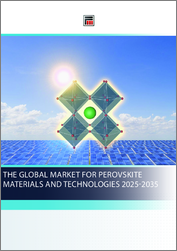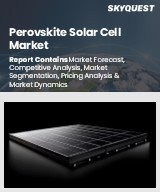
|
시장보고서
상품코드
1642229
세계의 페로브스카이트 소재 및 기술 시장(2025-2035년)The Global Market for Perovskite Materials and Technologies 2025-2035 |
||||||
세계 페로브스카이트 소재 및 기술 시장은 급속한 성장세를 보이고 있으며, 세계 연구자, 산업계, 투자자들로부터 큰 관심을 받고 있습니다. 페로브스카이트는 독특한 결정구조를 가진 재료의 일종으로, 뛰어난 광전자 특성, 저비용 생산, 다용도로 인해 다양한 응용 분야에서 유망한 솔루션으로 부상하고 있습니다. 페로브스카이트 시장의 주요 촉진요인은 고효율, 비용 효율적이고 지속 가능한 에너지 솔루션에 대한 수요 증가입니다. 페로브스카이트 태양전지(PSC)는 최근 몇 년동안 크게 발전하여 실험실 환경에서의 전력 변환 효율이 현재 25%(2009년 3%)를 넘어섰습니다. 이는 PSC를 기존 실리콘 기반 태양광 발전에 대한 강력한 도전자로 자리매김하고 있습니다. 저온, 용액 기반 공정으로 페로브스카이트 필름을 생산할 수 있기 때문에 확장 가능한 제조 및 유연한 기판과의 통합에 매력적입니다. 생산 비용이 낮고, 에너지 효율이 높으며, 유연한 기판 및 유리 기판에 대한 적응성이 높습니다.
페로브스카이트는 태양광 발전 외에도 발광소자(LED), 광검출기, 센서, 트랜지스터, 저장장치, 촉매 등의 분야에도 적용되고 있으며, PeLED로 알려진 페로브스카이트 LED는 색순도가 높고, 조정이 가능하며, 저비용으로 제조할 수 있어 디스플레이 및 조명 응용 분야에 적합합니다. 디스플레이 및 조명용으로 적합합니다. 페로브스카이트 기반의 광 검출기 및 센서는 고감도, 광범위한 스펙트럼 응답 및 빠른 응답 시간을 보여 이미징, 모니터링 및 환경 모니터링에 적용될 것으로 예상됩니다.
페로브스카이트 시장은 아직 초기 단계에 있습니다. 그러나 페로브스카이트 기반 제품의 채택이 증가하고 제조 공정의 규모가 확대됨에 따라 향후 몇 년동안 시장이 크게 성장할 것으로 예상됩니다. 세계 페로브스카이트 시장 규모는 2035년까지 100억 달러를 넘어설 것으로 예상되며, 태양광 발전 부문이 가장 큰 비중을 차지할 것으로 예상됩니다. 페로브스카이트 소재와 기술의 미래 전망은 유망하며, 안정성, 내구성, 성능 향상에 초점을 맞춘 연구가 진행 중입니다. 페로브스카이트와 실리콘 및 CIGS와 같은 다른 기존 기술과 결합된 탠덤 아키텍처는 전력 변환 효율을 향상시킬 것으로 예상됩니다. 태양광으로 작동하는 의복이나 센서 등 유연한 웨어러블 페로브스카이트 장치도 시야에 들어오고 있습니다. 페로브스카이트 양자점은 기존 소재에 비해 색 영역과 에너지 효율이 개선되어 디스플레이 및 조명 응용 분야에서의 가능성을 주목받고 있습니다.
그러나 장기적인 안정성, 효율성, 확장성, 페로브스카이트 제제에 함유된 독성 납의 존재 등의 문제가 남아있습니다. 연구자들은 이러한 문제를 해결하기 위해 무연 대체품 및 캡슐화 기술을 적극적으로 모색하고 있습니다.
이 보고서는 세계 페로브스카이트 소재 및 기술 시장에 대해 조사 분석했으며, 페로브스카이트 소재와 그 특성, 용도, 합성법, 시장 성장 촉진요인과 억제요인, 각 지역별 시장 예측, 경쟁 구도, 향후 기회 등의 정보를 제공합니다.
목차
제1장 주요 요약
- 시장 개요
- 기술 로드맵
- 시장 성장 촉진요인과 억제요인
- 시장 기회와 향후 동향
- 시장 예측
- 규제
제2장 서론
제3장 페로브스카이트 재료
- 무기 페로브스카이트
- 유/무기 하이브리드 페로브스카이트
제4장 페로브스카이트 합성법과 가공법
- 개요
- 용액 기반 방법
- 증착법
- 기타 합성법
- 측정할 수 있는 가공에 이용하는 성막 기술
- Roll-to-Roll Processing
- 합성 후 가공 기술
- 성막 방식 비교
제5장 페로브스카이트의 용도와 최종 용도 시장
- 태양광발전
- 발광소자
- 광검출기 및 센서
- 트랜지스터 및 기억장치
- 촉매 및 광촉매
- 열전
- 기타 새로운 용도
제6장 기업 개요(기업 65개사 개요)
제7장 부록
제8장 참고 문헌
LSH 25.02.21The global market for perovskite materials and technologies is experiencing rapid growth and attracting significant attention from researchers, industries, and investors worldwide. Perovskites, a class of materials with a unique crystalline structure, have emerged as a promising solution for various applications due to their exceptional optoelectronic properties, low-cost production, and versatility. The primary driver of the perovskite market is the increasing demand for high-efficiency, cost-effective, and sustainable energy solutions. Perovskite solar cells (PSCs) have demonstrated remarkable progress in recent years, with power conversion efficiencies now exceeding 25% (from 3% in 2009) in laboratory settings. This positions PSCs as a potential challenger to traditional silicon-based photovoltaics. The ability to produce perovskite films through low-temperature, solution-based processes makes them attractive for scalable manufacturing and integration with flexible substrates. They offer low production costs, high energy efficiency, and adaptability for flexible and glass substrates.
Beyond photovoltaics, perovskites are finding applications in light-emitting devices (LEDs), photodetectors, sensors, transistors, memory devices, and catalysis. Perovskite LEDs, known as PeLEDs, offer high color purity, tunability, and low-cost fabrication, making them suitable for display and lighting applications. Perovskite-based photodetectors and sensors exhibit high sensitivity, wide spectral response, and fast response times, with potential uses in imaging, surveillance, and environmental monitoring.
The perovskite market is still in its early stages. However, the market is expected to grow significantly in the coming years, driven by the increasing adoption of perovskite-based products and the scaling up of manufacturing processes. The global perovskite market will exceed $10 billion by 2035, with the photovoltaics segment accounting for the largest share. The future outlook for perovskite materials and technologies is promising, with ongoing research focused on improving stability, durability, and performance. Tandem architectures, combining perovskites with other established technologies like silicon or CIGS, are expected to push power conversion efficiencies. Flexible and wearable perovskite devices, such as solar-powered clothing and sensors, are also on the horizon. Perovskite quantum dots are attracting interest for their potential in display and lighting applications, offering improved color gamut and energy efficiency compared to conventional materials.
However, challenges remain in terms of long-term stability/efficiency, scalability, and the presence of toxic lead in some perovskite formulations. Researchers are actively exploring lead-free alternatives and encapsulation techniques to address these concerns.
The report covers the following key aspects:
- Overview of perovskite materials and their unique properties
- Types of perovskites: inorganic, hybrid organic-inorganic, and perovskite quantum dots
- Advantages of perovskites over traditional materials
- Perovskite applications and end-use markets
- Photovoltaics: perovskite solar cells (PSCs), tandem solar cells, and building-integrated photovoltaics (BIPV)
- Light-emitting devices: perovskite LEDs (PeLEDs), white light-emitting devices, lasers, and optical amplifiers
- Photodetectors and sensors: visible light, X-ray, gamma-ray, chemical, and humidity sensors
- Transistors and memory devices: field-effect transistors (FETs) and resistive random-access memory (RRAM)
- Catalysis and photocatalysis: water splitting, hydrogen production, CO2 reduction, and pollutant degradation
- Thermoelectrics and other emerging applications
- Perovskite synthesis and processing methods
- Solution-based methods: one-step deposition, two-step sequential deposition, and anti-solvent assisted crystallization
- Vapor deposition methods: thermal evaporation, co-evaporation, and chemical vapor deposition (CVD)
- Scalable processing techniques: inkjet printing, blade coating, slot-die coating, and spray coating
- Roll-to-roll processing for high-volume production and cost reduction
- Post-synthesis processing techniques: thermal annealing, solvent annealing, and pressure-assisted annealing
- Market drivers and restraints
- Market forecasts and regional analysis
- Global perovskite materials and technologies market size and growth rate from 2025 to 2035
- Market segmentation by application, material type, and geographic region
- Detailed market forecasts for North America, Europe, Asia-Pacific, and the Rest of the World
- Competitive landscape and company profiles
- Profiles of over 65 key players in the perovskite industry, including material suppliers and device manufacturers. Companies profiled include Aisin Corporation, Anker, Ascent Solar, Astronergy, Avantama, Beyond Silicon, Caelux, BrightComSol, Canadian Solar, Canon, China Huaneng Group Co., Ltd., Cosmos Innovation, CubicPV, DaZheng, Dyenamo, EneCoat Technologies, Energy Materials Corporation, Ergis Group, Flexell Space, GCL, Green Science Alliance Co., Ltd., Hangzhou Xianna Optoelectronic Technology Co., Ltd., Hanwha Qcells, Hefei BOE Solar Technology, Helio Display Materials, HETE Photo Electricity, Hiking PV, Homerun Resources, Huasun Energy (Ningxia Huasun New Materials Technology), JA Solar, Jiangsu Xiehang Energy Technology (Fellow Energy/Xiehang Energy), Jinko Solar, Kaneka Corporation, Koreakiyon, LONGi Green Energy Technology, Mellow Energy, Microquanta Semiconductor, Nanolumi, Nexwafe, Opteria, Oxford PV, PEROLED Korea, PeroNova, Perovskia Solar, Power Roll, PXP, Renshine Solar, RISEN, Saule Technologies, SCHOTT, SEI Energy Technology (Jiaxing), Sekisui Chemical Co Ltd, SN Display Co., Ltd., Sofab Inks, Solaronix, Solaveni GmbH, Solaires Enterprises, and more....
- Analysis of their strategies, partnerships, and product offerings
- Regulations and environmental considerations
- Future trends and opportunities
- Tandem solar cells and perovskite-silicon integration
- Flexible and wearable perovskite devices
- Perovskite quantum dots for displays and lighting
- Perovskite-based sensors for IoT and smart cities
- Recyclable and eco-friendly perovskite materials
TABLE OF CONTENTS
1. EXECUTIVE SUMMARY
- 1.1. Market Overview
- 1.2. Technology roadmap
- 1.3. Market drivers and restraints
- 1.3.1. Market Drivers
- 1.3.1.1. Increasing Demand for Renewable Energy
- 1.3.1.2. Declining Costs of Perovskite Production
- 1.3.1.3. Government Policies and Incentives
- 1.3.1.4. Advancements in Perovskite Stability and Efficiency
- 1.3.2. Market Restraints
- 1.3.2.1. Lead Toxicity Concerns
- 1.3.2.2. Stability and Degradation Issues
- 1.3.2.3. Scalability and Manufacturing Challenges
- 1.3.2.4. Competition from Established Technologies
- 1.3.1. Market Drivers
- 1.4. Market opportunities and future trends
- 1.4.1. Tandem Solar Cells and Perovskite-Silicon Integration
- 1.4.2. Flexible and Wearable Perovskite Devices
- 1.4.3. Perovskite Quantum Dots for Displays and Lighting
- 1.4.4. Perovskite-Based Sensors for IoT and Smart Cities
- 1.4.5. Perovskite Materials for Neuromorphic Computing
- 1.4.6. Recyclable and Eco-Friendly Perovskites
- 1.5. Market forecasts
- 1.5.1. Global Perovskite Materials and Technologies Market Size and Growth Rate
- 1.5.2. Market Forecasts by Application
- 1.5.3. Market Forecasts by Region
- 1.5.3.1. North America
- 1.5.3.2. Europe
- 1.5.3.3. China
- 1.5.3.4. Asia-Pacific
- 1.5.3.5. Rest of World
- 1.6. Regulations
- 1.6.1. Regulations and Standards for Perovskite Materials
- 1.6.2. Toxicity and Environmental Concerns
- 1.6.3. Disposal and Recycling Strategies
- 1.6.4. Occupational Health and Safety Measures
2. INTRODUCTION
- 2.1. What are Perovskites?
- 2.1.1. Perovskite Structure and Composition
- 2.1.2. Types of Perovskites
- 2.1.2.1. Inorganic Perovskites
- 2.1.2.2. Hybrid Organic-Inorganic Perovskites
- 2.1.3. Perovskite Properties
- 2.2. Advantages of Perovskite Materials
- 2.3. Challenges and Limitations
3. PEROVSKITE MATERIALS
- 3.1. Inorganic Perovskites
- 3.1.1. Lead-Based Perovskites
- 3.1.1.1. Methylammonium Lead Triiodide (MAPbI3)
- 3.1.1.2. Formamidinium Lead Triiodide (FAPbI3)
- 3.1.1.3. Cesium Lead Triiodide (CsPbI3)
- 3.1.2. Lead-Free Perovskites
- 3.1.2.1. Tin-Based Perovskites
- 3.1.2.2. Bismuth-Based Perovskites
- 3.1.2.3. Double Perovskites
- 3.1.3. Other Inorganic Perovskites
- 3.1.1. Lead-Based Perovskites
- 3.2. Hybrid Organic-Inorganic Perovskites
- 3.2.1. 3D Hybrid Perovskites
- 3.2.2. 2D Hybrid Perovskites (Ruddlesden-Popper Phases)
- 3.2.3. Quasi-2D Hybrid Perovskites
- 3.2.4. 1D Hybrid Perovskites
- 3.2.5. Perovskite Quantum Dots
- 3.2.5.1. Properties
- 3.2.5.2. Comparison to conventional quantum dots
- 3.2.5.3. Synthesis methods
- 3.2.5.4. Applications
- 3.2.5.5. Companies
4. PEROVSKITE SYNTHESIS AND PROCESSING METHODS
- 4.1. Overview
- 4.2. Solution-Based Methods
- 4.2.1. One-Step Deposition
- 4.2.2. Two-Step Sequential Deposition
- 4.2.3. Anti-Solvent Assisted Crystallization
- 4.2.4. Vapor-Assisted Solution Process
- 4.2.5. Spin Coating
- 4.3. Vapor Deposition Methods
- 4.3.1. Thermal Evaporation
- 4.3.2. Co-Evaporation
- 4.3.3. Chemical Vapor Deposition (CVD)
- 4.3.4. Hybrid Chemical Vapor Deposition
- 4.3.5. Aerosol Assisted Chemical Vapor Deposition
- 4.3.6. Sputtering
- 4.4. Other Synthesis Methods
- 4.4.1. Mechanochemical Synthesis
- 4.4.2. Combustion Synthesis
- 4.4.3. Hydrothermal Synthesis
- 4.5. Deposition Techniques for Scalable Processing
- 4.5.1. Inkjet Printing
- 4.5.2. Blade Coating
- 4.5.3. Slot-Die Coating
- 4.5.4. Spray Coating
- 4.6. Roll-to-Roll Processing
- 4.6.1. Overview of Roll-to-Roll Printing for Perovskites
- 4.6.2. Advantages for High-Volume Production and Cost Reduction
- 4.6.3. Challenges in Perovskite Film Deposition
- 4.6.4. Examples of Roll-to-Roll Perovskite Device Fabrication
- 4.7. Post-Synthesis Processing Techniques
- 4.7.1. Thermal Annealing
- 4.7.2. Solvent Annealing
- 4.7.3. Pressure-Assisted Annealing
- 4.8. Comparison of Deposition Methods
- 4.8.1. Overview of Method Advantages and Limitations
- 4.8.2. Guidelines for Choosing a Perovskite Deposition Method
5. PEROVSKITE APPLICATIONS AND END-USE MARKETS
- 5.1. Photovoltaics
- 5.1.1. Global solar power market
- 5.1.2. Photovoltaic (PV) commercialization
- 5.1.3. Solar photovoltaic (PV) investment landscape
- 5.1.4. Thin film solar cells
- 5.1.4.1. Thin film solar PV market
- 5.1.4.2. Perovskite photovoltaics (PV)
- 5.1.5. Thin Film Perovskite Solar Cells (PSCs)
- 5.1.5.1. Applications
- 5.1.5.2. The n-i-p and p-i-n configurations
- 5.1.5.3. Mesoporous scaffolds
- 5.1.5.4. Perovskite solar technologies opportunity
- 5.1.5.5. Advantages
- 5.1.5.6. Costs
- 5.1.5.7. PSC Architectures and Device Structures
- 5.1.5.8. Advantages of PSCs over Silicon Solar Cells
- 5.1.5.9. Challenges and Stability Issues
- 5.1.5.10. Degradation
- 5.1.5.11. Additive engineering
- 5.1.5.12. Glass-glass encapsulation
- 5.1.5.13. Polymer encapsulation
- 5.1.5.14. Passivation layers
- 5.1.5.15. Perovskite PV value chain
- 5.1.6. Tandem Solar Cells
- 5.1.6.1. Applications
- 5.1.6.1.1. Building integration
- 5.1.6.1.2. Solar farms
- 5.1.6.2. Properties
- 5.1.6.3. Perovskite/silicon tandem solar cells
- 5.1.6.4. Configurations
- 5.1.6.5. Challenges
- 5.1.6.6. Companies
- 5.1.6.7. All Perovskite Tandem Solar Cells
- 5.1.6.7.1. Overview
- 5.1.6.7.2. Manufacturing
- 5.1.6.7.3. Band gap tuning
- 5.1.6.7.4. Advantages and limitations
- 5.1.6.7.5. Companies
- 5.1.6.1. Applications
- 5.1.7. Materials
- 5.1.7.1. Substrate materials
- 5.1.7.1.1. Rigid glass substrates
- 5.1.7.1.2. Flexible glass substrates
- 5.1.7.1.3. Plastic substrates
- 5.1.7.1.4. Metal Foil Substrates
- 5.1.7.1.5. Transparent conducting films
- 5.1.7.1. Substrate materials
- 5.1.8. Rooftop installation
- 5.1.9. Space and Aerospace Applications
- 5.1.10. Indoor energy harvesting
- 5.1.11. Automotive
- 5.1.12. Agrivoltaics
- 5.1.13. Market players
- 5.1.14. Global perovskite PV market to 2035
- 5.2. Light-Emitting Devices
- 5.2.1. Light emitting diodes market
- 5.2.2. Perovskite Light-Emitting Diodes (PeLEDs)
- 5.2.2.1. Applications
- 5.2.3. White Light-Emitting Devices
- 5.2.4. Lasers and Optical Amplifiers
- 5.3. Photodetectors and Sensors
- 5.3.1. Thin film photodetectors market
- 5.3.2. Visible Light Photodetectors
- 5.3.3. X-Ray Detectors
- 5.3.4. Gamma-Ray Detectors
- 5.3.5. Chemical Sensors
- 5.3.6. Humidity Sensors
- 5.4. Transistors and Memory Devices
- 5.4.1. Field-Effect Transistors (FETs)
- 5.4.2. Resistive Random-Access Memory (RRAM)
- 5.5. Catalysis and Photocatalysis
- 5.5.1. Water Splitting and Hydrogen Production
- 5.5.2. CO2 Reduction and Conversion
- 5.5.3. Organic Synthesis
- 5.5.4. Pollutant Degradation
- 5.6. Thermoelectrics
- 5.7. Other Emerging Applications
- 5.7.1. Piezoelectrics
- 5.7.2. Superconductors
- 5.7.3. Spintronics
- 5.7.4. Batteries and Supercapacitors
6. COMPANY PROFILES (65 company profiles)
7. APPENDICES
- 7.1. List of Terms and Abbreviations
- 7.2. Research Methodology



















